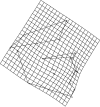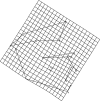Morphometric analysis of treatment effects of the Balters bionator in growing Class II patients
- PMID: 23137316
- PMCID: PMC8763078
- DOI: 10.2319/072512-605.1
Morphometric analysis of treatment effects of the Balters bionator in growing Class II patients
Abstract
Objective: To investigate the effects of the standard (Class II) Balters bionator in growing patients with Class II malocclusion with mandibular retrusion by using morphometrics (thin-plate spline [TPS] analysis).
Materials and methods: Thirty-one Class II patients (17 male and 14 female) were treated with the Balters bionator (bionator group). Mean age at the start of treatment (T0) was 10.3 years, while it was 13 years at the end of treatment (T1). Mean treatment time was 2 years and 2 months. The control group consisted of 22 subjects (14 male and 8 female) with untreated Class II malocclusion. Mean age at T0 was 10.2 years, while it was 12.2 years at T1. The observation period lasted 2 years on average. TPS analysis evaluated statistical (permutation tests) differences in the craniofacial shape and size between the bionator and control groups.
Results: Through TPS analysis (deformation grids) the bionator group showed significant shape changes in the mandible that could be described as a mandibular forward and downward displacement. The control group showed no statistically significant differences in the correction of Class II malocclusion.
Conclusions: Bionator appliance is able to induce significant mandibular shape changes that lead to the correction of Class II dentoskeletal disharmony.
Figures





Similar articles
-
Morphometric analysis of long-term dentoskeletal effects induced by treatment with Balters bionator.Angle Orthod. 2015 Sep;85(5):790-8. doi: 10.2319/080714-554.1. Epub 2014 Dec 3. Angle Orthod. 2015. PMID: 25469744 Free PMC article.
-
Changes on facial profile in the mixed dentition, from natural growth and induced by Balters' bionator appliance.Dental Press J Orthod. 2013 Mar-Apr;18(2):108-15. doi: 10.1590/s2176-94512013000200022. Dental Press J Orthod. 2013. PMID: 23916440
-
Mandibular growth and dentoalveolar development in the treatment of class II, division 1, malocclusion using Balters Bionator according to the skeletal maturation.Dental Press J Orthod. 2013 Jul-Aug;18(4):43-52. doi: 10.1590/s2176-94512013000400008. Dental Press J Orthod. 2013. PMID: 24262416
-
National Institute of Dental and Craniofacial Research efficacy trials of bionator class II treatment: a review.Angle Orthod. 2002 Dec;72(6):571-5. doi: 10.1043/0003-3219(2002)072<0571:NIODAC>2.0.CO;2. Angle Orthod. 2002. PMID: 12518950 Review.
-
Mandibular propulsion appliance for adults with Class II malocclusion: a systematic review and meta-analysis.Eur J Orthod. 2020 Apr 1;42(2):163-173. doi: 10.1093/ejo/cjz089. Eur J Orthod. 2020. PMID: 31786599
Cited by
-
Thin-plate spline analysis of mandibular shape changes induced by functional appliances in Class II malocclusion : A long-term evaluation.J Orofac Orthop. 2016 Sep;77(5):325-33. doi: 10.1007/s00056-016-0041-5. Epub 2016 Jun 29. J Orofac Orthop. 2016. PMID: 27357583 Clinical Trial. English.
-
Long-term (≥ 15 years) outcome quality after Class II:1 bionator or Herbst multibracket appliance treatment : A comparison.J Orofac Orthop. 2024 Jul;85(4):260-269. doi: 10.1007/s00056-023-00457-3. Epub 2023 Feb 24. J Orofac Orthop. 2024. PMID: 36826527 Free PMC article.
-
3D Comparison of Mandibular Response to Functional Appliances: Balters Bionator versus Sander Bite Jumping.Biomed Res Int. 2018 Apr 24;2018:2568235. doi: 10.1155/2018/2568235. eCollection 2018. Biomed Res Int. 2018. PMID: 29854734 Free PMC article.
-
Twenty-year follow-up of functional treatment with a bionator appliance: A retrospective dental cast analysis.Angle Orthod. 2020 Mar;90(2):209-215. doi: 10.2319/042419-292.1. Epub 2019 Sep 4. Angle Orthod. 2020. PMID: 31483143 Free PMC article.
-
Morphometric analysis of long-term dentoskeletal effects induced by treatment with Balters bionator.Angle Orthod. 2015 Sep;85(5):790-8. doi: 10.2319/080714-554.1. Epub 2014 Dec 3. Angle Orthod. 2015. PMID: 25469744 Free PMC article.
References
-
- Broadbent BH. A new x-ray technique and its applications to orthodontia. Angle Orthod. 1931;1:45–66.
-
- Hofrath H. Bedeutung der Röntgenfern und Abstandsaufnahme für die Diagnostik der Kieferanomalien. Fortschr Orthod. 1931;1:232–258.
-
- Moyers RE, Bookstein FL. The inappropriateness of conventional cephalometrics. Am J Orthod. 1979;75:599–617. - PubMed
-
- Bookstein FL. On the cephalometrics of skeletal change. Am J Orthod. 1982;82:177–182. - PubMed
-
- McIntyre GT, Mossey PA. Size and shape measurement in contemporary cephalometrics. Eur J Orthod. 2003;25:231–242. - PubMed
MeSH terms
LinkOut - more resources
Full Text Sources

